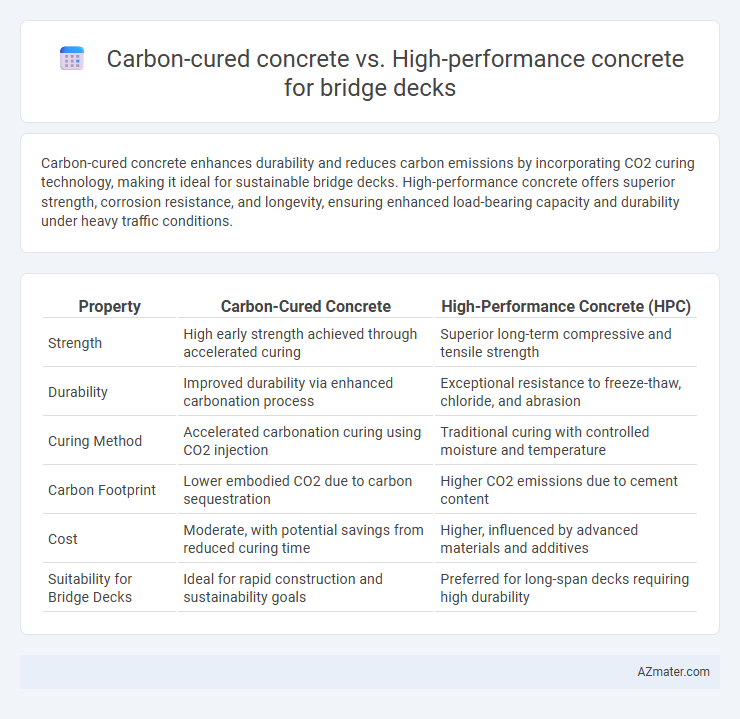Carbon-cured concrete enhances durability and reduces carbon emissions by incorporating CO2 curing technology, making it ideal for sustainable bridge decks. High-performance concrete offers superior strength, corrosion resistance, and longevity, ensuring enhanced load-bearing capacity and durability under heavy traffic conditions.
Table of Comparison
| Property | Carbon-Cured Concrete | High-Performance Concrete (HPC) |
|---|---|---|
| Strength | High early strength achieved through accelerated curing | Superior long-term compressive and tensile strength |
| Durability | Improved durability via enhanced carbonation process | Exceptional resistance to freeze-thaw, chloride, and abrasion |
| Curing Method | Accelerated carbonation curing using CO2 injection | Traditional curing with controlled moisture and temperature |
| Carbon Footprint | Lower embodied CO2 due to carbon sequestration | Higher CO2 emissions due to cement content |
| Cost | Moderate, with potential savings from reduced curing time | Higher, influenced by advanced materials and additives |
| Suitability for Bridge Decks | Ideal for rapid construction and sustainability goals | Preferred for long-span decks requiring high durability |
Introduction to Bridge Deck Materials
Carbon-cured concrete offers enhanced durability and reduced carbon footprint through accelerated curing with CO2, making it a sustainable option for bridge decks. High-performance concrete (HPC) provides superior strength, improved workability, and increased resistance to environmental stressors such as chloride penetration and freeze-thaw cycles. Selecting between carbon-cured concrete and HPC depends on project priorities including longevity, environmental impact, and structural requirements for bridge deck applications.
Understanding Carbon-Cured Concrete
Carbon-cured concrete leverages carbon dioxide injection during the curing process to enhance strength and durability, making it a sustainable option for bridge decks by reducing CO2 emissions and improving resistance to corrosion. This innovative method accelerates the carbonation reaction within the concrete matrix, resulting in a denser microstructure and increased compressive strength compared to conventional high-performance concrete (HPC). While HPC is engineered for superior mechanical properties and durability through optimized mix design and advanced admixtures, carbon-cured concrete offers a compelling environmental advantage by integrating carbon capture directly into the curing process.
Overview of High-Performance Concrete
High-performance concrete (HPC) for bridge decks offers superior strength, durability, and resistance to environmental stressors compared to traditional concrete mixtures. HPC typically incorporates supplementary cementitious materials such as silica fume or fly ash, optimized aggregate gradation, and advanced admixtures to enhance mechanical properties and reduce permeability. This results in improved load-bearing capacity, reduced maintenance costs, and extended service life for bridge structures exposed to heavy traffic and harsh climates.
Key Material Properties Comparison
Carbon-cured concrete exhibits enhanced early strength gain due to accelerated carbonation, resulting in improved durability and reduced permeability compared to traditional curing methods. High-performance concrete (HPC) offers superior compressive strength, increased tensile capacity, and enhanced resistance to chloride ingress, freeze-thaw cycles, and abrasion, making it highly suitable for demanding bridge deck applications. While carbon-cured concrete emphasizes rapid strength development and sustainability, HPC provides a balanced combination of long-term durability and mechanical performance essential for extended service life in bridge decks.
Strength and Durability Under Load
Carbon-cured concrete demonstrates enhanced compressive strength and improved resistance to early-age cracking, contributing to prolonged durability under sustained loading conditions. High-performance concrete (HPC) offers superior tensile strength and optimized microstructure, which significantly reduces permeability and increases longevity under high traffic and environmental stress. Both materials deliver robust performance in bridge deck applications, with carbon-cured concrete excelling in early strength gain and HPC providing long-term durability and resistance to load-induced deterioration.
Resistance to Corrosion and Environmental Effects
Carbon-cured concrete exhibits enhanced resistance to corrosion through improved carbonation curing processes that densify the concrete matrix, reducing permeability and limiting chloride ion penetration in bridge decks. High-performance concrete (HPC) offers superior durability with optimized mix designs incorporating supplementary cementitious materials and lower water-to-cement ratios that minimize porosity and resist environmental degradation such as freeze-thaw cycles and chemical attacks. Both materials improve bridge deck longevity, but carbon-cured concrete specifically targets accelerated carbonation for corrosion mitigation, while HPC provides comprehensive environmental durability through advanced material engineering.
Sustainability and Carbon Footprint
Carbon-cured concrete for bridge decks significantly reduces carbon emissions by utilizing CO2 in the curing process, capturing up to 500 kg of CO2 per cubic meter, enhancing sustainability compared to traditional high-performance concrete (HPC). High-performance concrete, while offering superior durability and strength, often involves higher cement content, contributing to a larger carbon footprint due to energy-intensive production processes. Choosing carbon-cured concrete aligns with green infrastructure goals by lowering greenhouse gas emissions and promoting circular carbon usage in bridge construction.
Installation and Curing Processes
Carbon-cured concrete for bridge decks utilizes a carbonation curing process where CO2 is injected during curing, accelerating strength gain and enhancing durability by reducing permeability. High-performance concrete (HPC) relies on conventional wet curing methods with extended moist curing periods to achieve superior mechanical properties and long-term durability. Installation of carbon-cured concrete often requires enclosed curing chambers with controlled CO2 environments, whereas HPC installation follows standard practices but demands strict moisture control during the curing phase.
Cost Analysis and Long-term Value
Carbon-cured concrete offers lower upfront costs due to reduced curing time and energy consumption, making it economically attractive for bridge deck construction. High-performance concrete demands higher material and production expenses but provides superior durability and resistance to environmental stressors, potentially lowering maintenance costs over the bridge's lifespan. Long-term value assessment favors high-performance concrete when considering lifecycle costs, while carbon-cured concrete benefits projects with tight budgets and shorter design lives.
Future Trends in Bridge Deck Construction
Carbon-cured concrete offers enhanced durability and reduced carbon footprint, making it a promising material for sustainable bridge deck construction. High-performance concrete (HPC) continues to evolve with improved tensile strength and resistance to environmental stressors, supporting longer service life and reduced maintenance. Future trends emphasize integrating carbon curing technology with HPC formulations to optimize both environmental impact and structural performance in bridge decks.

Infographic: Carbon-cured concrete vs High-performance concrete for Bridge deck
 azmater.com
azmater.com